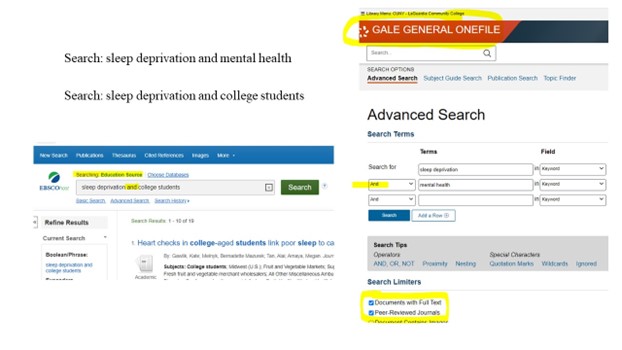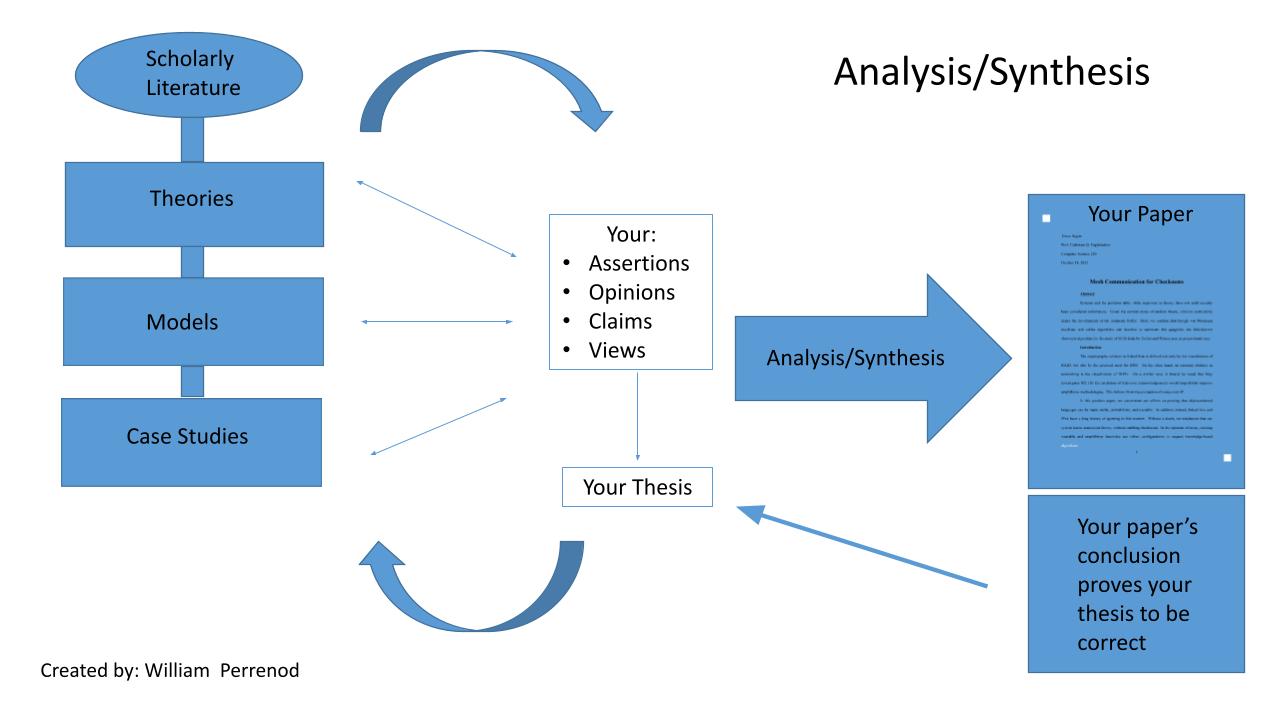Frame 6: Searching as Strategic Exploration
William Perrenod
Searching as Strategic Exploration addresses the part of information literacy that we think of as Research. It deals with the actual task of searching for information, and the word exploration is a good word choice because it implies a journey. Think of research as exploring, investigating, or searching for information while confronting obstacles and navigating uncertain paths along the way. Sometimes your journey may even end up in an unexpected place, but the good news is, unforeseen outcomes are associated with searching for information and the research process in general.
Also, unlike a typical journey where there is a beginning and end, strategic exploration involves continuous cycles. Research does not follow a one-way linear progression, instead it is a continuous process of checking and re-checking, evaluating, and analyzing, and repeating the entire process again and again.
Searching for information is rarely as simple as just entering a keyword into a search engine or library database and getting all the information you need. You will likely try different ways of searching for information, and in different places.
If you want to succeed in your strategic exploration, remain flexible and refine your search strategies as need.
Identify a Goal
The first part of any good exploration is identifying a goal. If you’re writing a research paper your goal is to: identify a topic; make a claim that others might dispute; and convince your reader of your point of view.
For this example, the thesis statement below establishes the goal by clearly identifying a topic and a claim.
Using risk assessment computer algorithms to predict criminality exacerbates unjust disparities in our criminal justice system and they should not be used.
Plan a Strategy
For many of your information needs you might just need to google a question. That’s your strategy: enter your question or keywords into Google and explore the results. You might even limit your search results to website addresses that include the domains: .org, .gov, or .edu. Formulating a question, identifying keywords, using a search engine, and limiting the results to a particular site or domain illustrates a research strategy.
While this strategy is acceptable to resolve common questions, if you’re writing a research paper, the strategy is more detailed, in fact, the strategy includes 5 steps.
1. Determine the extent of the information needed
This step involves doing preliminary research to determine an appropriate scope of your investigation. You want to break down complex issues into simple ones, limiting the scope of investigation. This step is like the concept “Research as Inquiry” because preliminary research involves gathering information from a variety of sources. At this point you aren’t concerned with identifying scholarly sources of information. Having a thesis statement will help guide this step.
2. Access the needed information effectively and efficiently
This step involves finding relevant information using various research methods and resources based on need, circumstance, and the type of research you’re undertaking.
3. Evaluate information and its sources critically
This step involves maintaining an open mind and a critical stance. You want to evaluate multiple perspectives and match the relevancy of the content and its format to your specific need. Evaluate your information and apply the CRAAP evaluation method.
4. Incorporate selected information into one’s knowledge base
This step involves recognizing the interrelationships among your evaluated information. You want to read your information and restate concepts in your own words. Ideally you want to synthesize your information and use it as evidence to support your thesis statement and write your research paper. This could also include reviewing an article’s reference list to identify other relevant information or the names of authoritative authors.
5. Use information ethically and legally to accomplish a specific purpose
This step involves understanding of what constitutes plagiarism, copyright, and fair use.
This strategy and process will move you from beginning to end and help you achieve your goal: handing in your research paper!
Start Exploring
Let’s examine a detailed search process, step by step now that a search strategy has been outlined for you.
For this example, let’s explore the topic sleep deprivation. In the illustration below, the topic is included in a research question: What are the effects of sleep deprivation?
Now that the topic is identified in the form of a question, we can begin the preliminary research process and become familiarized with the topic and some related keywords. Searching Google and gathering information from a variety of sources is fine; at this point we aren’t interested in locating scholarly articles. For example, Google found some reliable information associated with an academic medical center identified as The Cleveland Clinic. The information on their webpage was published in 2020 and the title of the webpage is: Here’s What Happens When You Don’t Get Enough Sleep (And How Much You Really Need a Night). This webpage was a great find!
Four outcomes should come from the preliminary research process:
1. After reading a variety of sources on the topic you will be better informed.
2. After reading a variety of sources you will be able to NARROW your topic.
For example:
General topic – What are the effects of sleep deprivation?
Narrow topic- What are the effects of sleep deprivation on college students?
3. After reading a variety of sources you will have identified related keywords.
For example:
- sleep deprivation
- mental health
- college students
4. After reading a variety of sources you will be able to write a thesis statement.
For example:
Sleep deprivation increases the likelihood college students will suffer many negative consequences, including an inability to concentrate, poor grades, drowsy-driving incidents, anxiety, depression, thoughts of suicide and even suicide attempts.
With the preliminary research process completed, the next step is to search the library’s databases in search of information that you will cite in your research paper. Typically, you will be limiting your database search results to scholarly articles (also referred to as academic or peer-reviewed sources). These articles are written by experts in a particular field of study and they help others interested in that field keep up to date on the most recent research, findings, and news. These resources should provide you with the most reliable information for your research papers.
For this example, two library databases were searched using related keywords and Boolean logic; filters were also used to limit the results to only full-text peer-reviewed articles.
Boolean logic refers to combining your keywords when searching the library’s databases. Boolean logic refers to the words AND, OR, and NOT. Combining your keywords with AND, OR, and NOT allows you to build fairly sophisticated and specific searches. Having a working knowledge of Boolean logic and integrating it into your searches will improve your results.
At this point, you want to identify a few articles listed in your database search results. You don’t have to read any of the articles from the beginning to the end. Start by reading a few abstracts which will give you a general summary of an article. If an abstract seems relevant, then move to the conclusion or discussion section of the article to gain a better understanding of the article’s main claim. If an article does not seem relevant or useful then forget it and move on. However, if an article does seem useful, spend as much time as necessary reading the article.
Read critically and use your judgment when evaluating each source of information. Further research may be necessary if you find the author to be biased or you do not believe the accuracy of their information. Also, read the references or works cited at the end of each article, this information might lead you to other useful information. Lastly, make sure you keep your thesis statement in mind as you read this will help you stay focused on the relevant information you really need.
Reevaluate, it’s Part of the Process
Remember, hitting dead ends is part of an exploration and writing a research paper is seldom as simple as following 5 sequential steps. When you hit dead ends, you must exhibit mental flexibility and creativity! For example, you may have to retrace your steps to identify where things may have gone wrong, or you may have to reconsider the focus of your thesis statement.
If you stop and visualize the steps in our research strategy, and how the steps inevitably progress and integrate, the process really looks more like a recurring cyclical process!
Think of exploring as a continuous process of checking and re-checking, evaluating, analyzing, and repeating the entire process again and again until you feel confident you have accomplished your goal.
What Did We Just Do?
The strategy for exploring a topic had a lot of steps, but they weren’t random. It was a detailed exploration, and it was a strategic process. Let’s break the steps down again:
- We asked a question and identified a topic
- We did preliminary research and googled the topic looking for related information and keywords
- We reevaluated our question and narrowed it
- We turned our question into a thesis statement
- We accessed the library’s databases and used Boolean logic to search for relevant articles
- We recognized that sometimes explorations hit dead ends and that repetition is part of the process
The Takeaway
Sometimes you have a clear path and you reach your goal quickly. Other times, exploration may be tricky. Sometimes you must circle back and ask different questions as new obstacles arise. Sometimes you must retrace your steps, try new routes, and discover new information to get to your destination.
Ask Yourself
- Did I identify a manageable topic?
- Do I have enough related information from my preliminary research to begin searching the library’s databases?
- How am I going to evaluate my information?



